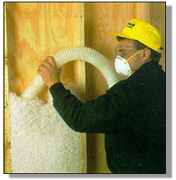
These insulation values are minimums. Typically, the cost of adding a little extra insulation is minimal once a contractor is on site.
For wall insulation, most are limited in the amount of insulation in the walls because the thickness of the wall is already determined. Methods of filling walls, such as dense packing, tube filling, wet blowing, or using certain types of foams
can improve the overall R-value, and you should discuss these options with a contractor. Ask your contractor to check the wall to make certain the existing insulation has not settled. If you’re not certain if the walls have insulation, the contractor can also check by accessing the walls near electrical outlets. This should only be done by a trained professional.
* Note: Crawl spaces can be a moisture source and proper crawl space design is essential for good indoor air quality.
For more information on mold visit the following web sites:
- http://www.crawlspaces.org">www.crawlspaces.org
- http://www.eeba.org/resources/consumer/mold.htm">www.eeba.org/resources/consumer/mold.htm
- http://www.buildingscience.com">www.buildingscience.com
- http://www.schs.state.nc.us/epi/oii/mold">www.schs.state.nc.us/epi/oii/mold
- http://www.AdvancedEnergy.org">www.AdvancedEnergy.org
Home
Energy
Loans
Energy Statistics
mailto:energy1%40mail%2estate%2ene%2eus">  State
of Nebraska Home
Disclaimer
State
of Nebraska Home
Disclaimer
|
 The first part of this question, “Is more insulation needed?” can be difficult to answer. Up to a certain point, insulation will pay for itself by reducing energy costs. Where the cost effectiveness point is varies depending on the cost of energy and the cost of insulation. Another factor is the efficiency of heating and cooling equipment.
For example, if the home (or business) has no insulation, a substantial amount of insulation could be purchased before the point was reached where the insulation would no longer pay for itself in energy savings. On the other hand, if that home or business already had a fair amount of insulation, adding insulation might be hard to justify economically.
If a home or business has very efficient heating and cooling equipment, the savings that can be achieved by adding insulation will be reduced, compared to a home or business with less efficient heating and cooling equipment which would have a higher potential for savings. The reverse of this is true for insulation in a home or business. The amount of insulation will affect the potential for savings associated with upgrading heating and cooling equipment, and the size of that equipment.
The first part of this question, “Is more insulation needed?” can be difficult to answer. Up to a certain point, insulation will pay for itself by reducing energy costs. Where the cost effectiveness point is varies depending on the cost of energy and the cost of insulation. Another factor is the efficiency of heating and cooling equipment.
For example, if the home (or business) has no insulation, a substantial amount of insulation could be purchased before the point was reached where the insulation would no longer pay for itself in energy savings. On the other hand, if that home or business already had a fair amount of insulation, adding insulation might be hard to justify economically.
If a home or business has very efficient heating and cooling equipment, the savings that can be achieved by adding insulation will be reduced, compared to a home or business with less efficient heating and cooling equipment which would have a higher potential for savings. The reverse of this is true for insulation in a home or business. The amount of insulation will affect the potential for savings associated with upgrading heating and cooling equipment, and the size of that equipment.
 The 2003 International Energy Conservation Code (IECC) provides some guidance in this area. The introduction to the IECC describes itself as “…an energy conservation code that adequately conserves energy; provisions that do not unnecessarily increase construction costs…” The IECC is a set of minimum requirements, and that buildings are being constructed that are well beyond the requirements of the IECC. These buildings meetLeadership in Energy and Environmental Design, or LEED, and Energy Star standards. If the insulation in the home meets the minimum requirements listed in the IECC, you have at least met the minimum requirements set by most states.
For Nebraska, the IECC prescriptive requirements vary from southern Nebraska to north and northwest Nebraska, with southern Nebraska having the lower R-value requirements. These insulation ranges are:
The 2003 International Energy Conservation Code (IECC) provides some guidance in this area. The introduction to the IECC describes itself as “…an energy conservation code that adequately conserves energy; provisions that do not unnecessarily increase construction costs…” The IECC is a set of minimum requirements, and that buildings are being constructed that are well beyond the requirements of the IECC. These buildings meetLeadership in Energy and Environmental Design, or LEED, and Energy Star standards. If the insulation in the home meets the minimum requirements listed in the IECC, you have at least met the minimum requirements set by most states.
For Nebraska, the IECC prescriptive requirements vary from southern Nebraska to north and northwest Nebraska, with southern Nebraska having the lower R-value requirements. These insulation ranges are:
